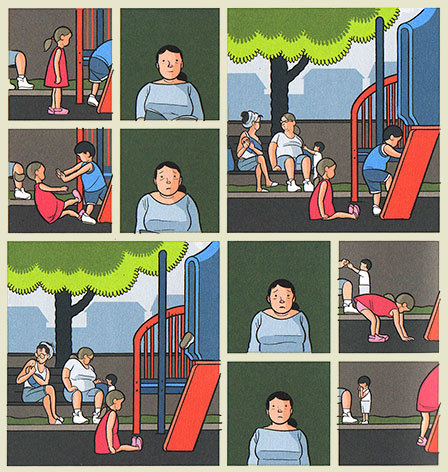Building Stories is one of the most celebrated comics from 2012. Calling it a “work” is a bit vague; it would be more accurate to call it a collection or a box. In the Building Stories box are 14 separate installments with no insight into what each piece is and where it starts or ends. Some pieces are tiny, others gigantic, some hard (one piece in particular looks like an elaborate game board) and some flimsy (tiny pamphlets and giant newsprint).

In the whole of Building Stories, Chris Ware examines an unnamed human being, a Woman and her relationships, with an intensity that can be at times frightening and off-putting. And while Ware is eager to show the life of his subject, he is not so eager to tell his reader how to start viewing that life. It is partially this nonlinear approach that makes Building Stories so appealing.
Personally, I started with the book that was patterned after a Little Golden Book, and then went from smallest piece to largest piece. This is one of millions, if not billions of ways to read Building Stories.
I think that depending on the way you read the collection, it will change your view of the Woman. Your preconceived notions and your judgment of her may form and then be broken, or harden over the course of the 14 pieces. In this sense, every way that the content is read changes the way the story unfolds and thereby the reader’s interaction with that story.

Clearly part of Ware’s ambitions with Building Stories is to show that print is not dead and that some stories can only be told in certain ways. Unlike other books, which can be digitized and read on a screen, Building Stories requires consideration of both the material and presentation for each of its 14 pieces. Why are the books in book form? Why choose to print comics on a quad-folded board? I grappled with these ideas as well as the story of the Woman.
I see the Building Stories collection as a take on human memory. We have moments in our lives that we hoard and use to define ourselves: a cross-country trip; a death; a graduation; a brief and caustic interaction on the train; a bully’s words from grade school. This is the essence of Building Stories, not that these collected pieces are the full story of the Woman’s life, but rather that these are the things that she has defined her life with, “built” her life with, if you like.
Because of Building Stories’ multi-part presentation, I wonder what I missed. What connections did I not make? If I read this again, what experience will I have? Memory is such a nebulous topic to take on in any book, but Ware’s examination of its cyclical, sometimes faded, sometimes revised and rerecorded nature in Building Stories is a success no matter how you read the collection.
